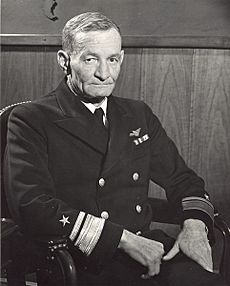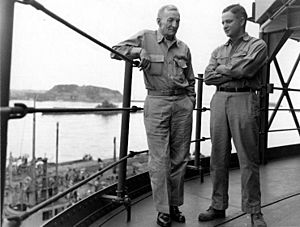John S. McCain Sr. facts for kids
Quick facts for kids
John S. McCain Sr.
|
|
|---|---|
 |
|
| Birth name | John Sidney McCain |
| Nickname(s) | Slew |
| Born | August 9, 1884 Carroll County, Mississippi, U.S. |
| Died | September 6, 1945 (aged 61) Coronado, California, U.S. |
| Place of burial | |
| Allegiance | |
| Service/ |
|
| Years of service | 1906–1945 |
| Rank | |
| Commands held | USS Ranger Air Forces for Western Sea Frontier and the South Pacific Force Bureau of Aeronautics Second Fast Carrier Force Task Group 38.1 Task Force 38 |
| Battles/wars | World War I World War II
|
| Awards | Navy Cross Navy Distinguished Service Medal (3) |
| Spouse(s) | Catherine Davey Vaulx |
| Relations | John S. McCain Jr. (son) John S. McCain III (grandson) |
John Sidney "Slew" McCain (born August 9, 1884 – died September 6, 1945) was a brave U.S. Navy admiral. He was a very important leader in the Pacific campaign during World War II. Admiral McCain was one of the first to understand how important aircraft carriers would be in naval battles.
He led many air operations, especially during the Guadalcanal campaign. Later, in 1944–45, he commanded the powerful Fast Carrier Task Force. His actions near the Philippines and Okinawa helped destroy a lot of Japanese naval and air power. He passed away just four days after Japan officially surrendered, ending the war.
Admiral McCain came from a family with a strong military history. Many of his family members also served in the U.S. Navy. He and his son, John S. McCain Jr., were the first father and son to both become four-star admirals in the U.S. Navy. His grandson, John S. McCain III, was a prisoner of war during the Vietnam War. His great-grandsons, John S. McCain IV and James McCain, continue this family tradition by serving in the U.S. Navy and U.S. Marine Corps today.
Contents
John Sidney McCain was born in Carroll County, Mississippi. His father was also named John Sidney McCain. Young John first went to the University of Mississippi. After two years, he decided to try for the United States Military Academy at West Point, where his brother was studying.
However, he also took the entrance exams for the United States Naval Academy. When he passed those and was accepted, he chose to join the Navy instead. This meant leaving behind his family's farm life for a life at sea.
At the Naval Academy, John McCain wasn't the best student. He had some hearing problems, but he was still allowed to join because the Navy needed many officers. He graduated in 1906, ranking 79th out of 116 students.
He married Katherine Davey Vaulx on August 9, 1909. She was eight years older than him.

After becoming an officer, McCain sailed around the world with the Great White Fleet from 1907 to 1909. He joined the battleship USS Connecticut for the final part of the journey. Later, he was sent to the Asiatic Squadron and then to the naval base in San Diego.
In 1914 and 1915, he served on the armored cruiser USS Colorado. This ship patrolled the Pacific coast of Mexico. In 1915, he joined the USS San Diego, which was a very important ship for the Pacific Fleet.
When the U.S. entered World War I, McCain and the San Diego helped protect ships traveling across the Atlantic Ocean. They escorted convoys through dangerous waters where submarines were a threat. McCain left the San Diego in May 1918, just two months before it was sunk. He was then assigned to the Bureau of Navigation.
Between the World Wars
In the 1920s and early 1930s, McCain served on several ships, including USS Maryland and USS New Mexico. His first time commanding a ship was on the USS Sirius.
In 1935, McCain started flight training. He earned his pilot's wings in 1936 at the age of 52, making him one of the oldest people to become a naval aviator. From 1937 to 1939, he commanded the aircraft carrier USS Ranger. In 1941, he was promoted to rear admiral and led the Aircraft Scouting Force of the Atlantic Fleet.
McCain was known for being tough and direct. He was a natural leader who inspired his crew. He was also known for being brave.
World War II Service
After Japan attacked Pearl Harbor in December 1941, McCain was put in charge of all land-based Allied air operations in the South Pacific in May 1942. This included supporting the Guadalcanal campaign in the Solomon Islands. The planes under McCain's command, like the Cactus Air Force at Henderson Field, were very important in defending Guadalcanal from Japanese attacks.
In October 1942, McCain was called to Washington, D.C., to lead the Bureau of Aeronautics. By August 1943, he became the Deputy Chief of Naval Operations for Air, with the rank of vice admiral.
McCain returned to combat in the Pacific in August 1944. He was appointed commander of a carrier group within Marc Mitscher's Task Force 58. In this role, McCain took part in the Marianas campaign, including the Battle of the Philippine Sea. He also helped start the Philippines campaign.
Battle of Leyte Gulf
At the Battle of Leyte Gulf, a large naval battle, Admiral William Halsey went after a Japanese decoy force. This left a smaller American force, called "Taffy 3," unprotected. Taffy 3 was then attacked by a much larger Japanese fleet.
The commander of Taffy 3, Rear Admiral Clifton "Ziggy" Sprague, urgently asked Halsey for help. McCain, who was part of Halsey's fleet, heard these calls for help. He knew how serious the situation was and decided to turn his ships around to help, even before he received official orders.
McCain's ships raced towards the battle. At 10:30 AM, his planes launched from carriers like USS Hornet and USS Hancock. They flew a long distance to attack the Japanese ships. Even though the attack didn't cause a lot of damage, it helped convince the Japanese commander to retreat.
On October 30, 1944, McCain took command of Task Force 38. He led this powerful force through the Battle of Okinawa and carried out air raids on the Japanese mainland.
While operating near the Philippines, McCain was involved in a decision to stay in the area despite a huge storm, Typhoon Cobra. This storm caused a lot of damage, sinking three destroyers and damaging many other ships. About 800 men and 146 aircraft were lost. A Navy investigation found that Halsey made a mistake in sailing into the typhoon. McCain was later ordered to hand over command of Task Force 38.
Death and Legacy
By the end of the war in August 1945, the stress of fighting had taken a toll on McCain's health. He asked for time off to rest, but Admiral Halsey wanted him to be present at the Japanese surrender ceremony in Tokyo Bay on September 2.
McCain left right after the ceremony. Just four days later, he died of a heart attack at his home in Coronado, California. His death was major news. He was buried at Arlington National Cemetery.
In 1949, McCain was given a special honor. Congress promoted him to full admiral after his death. This was because his bravery and service during the war would have earned him the promotion if he had lived longer. During his career, McCain received the Navy Distinguished Service Medal three times.
Family Heritage
The McCain family has a long history of service. John S. McCain's grandfather, William Alexander McCain, lived in Carrollton, Carroll County, Mississippi. His father, also named John Sidney McCain, served as a sheriff.
McCain's older brother, William Alexander McCain, also attended the United States Military Academy. He became a brigadier general in the Army and received awards for his actions in both World War I and World War II. An uncle, Henry Pinckney McCain, also became a major-general in the Army. Camp McCain, a training site in Mississippi, is named after him.
Admiral McCain's son, John S. McCain Jr., was a submarine commander in World War II. He later became a Commander in Chief Pacific Command (CINCPAC) during the Korean and Vietnam wars.
Admiral McCain's grandson, John S. McCain III, was a U.S. Navy captain during the Vietnam War. He became famous for spending five years as a prisoner of war in North Vietnamese camps. After leaving the Navy, he became a Congressman and Senator for Arizona. He also ran for President of the United States twice. His book, Faith of My Fathers, tells the story of his family's military history and his own experiences.
Admiral McCain's great-grandson, John Sidney "Jack" McCain IV, graduated from the U.S. Naval Academy in 2009 and is a naval aviator. Another great-grandson, James Hensley "Jimmy" McCain, joined the Marine Corps in 2006 and served in the Iraq War.
Namesakes
- McCain Field, a center at Naval Air Station Meridian in Mississippi, is named in his honor.
- Two guided-missile destroyers have been named after him:
- USS John S. McCain (DL-3) (served from 1953–1978)
- USS John S. McCain (DDG-56) (in service since 1994). This ship was also named for his son, John S. McCain Jr., and his grandson, Senator John S. McCain III.




